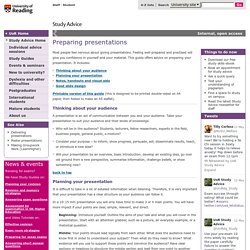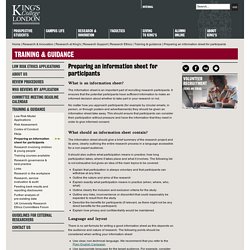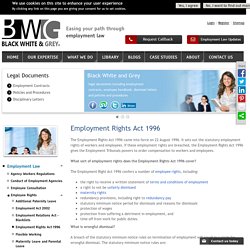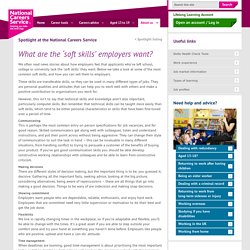

Preparing presentations. Most people feel nervous about giving presentations.

Feeling well-prepared and practised will give you confidence in yourself and your material. This guide offers advice on preparing your presentation. It includes: Preparing an information sheet for participants. Preparing an information sheet for participants What is an information sheet?

The information sheet is an important part of recruiting research participants. It ensures that the potential participants have sufficient information to make an informed decision about whether to take part in your research or not. No matter how you approach participants (for example by circular emails, in person, or through posters and advertisements) they should be given an information sheet take away. This should ensure that participants can consider their participation without pressure and have the information that they need in order to give informed consent. What should an information sheet contain? The information sheet should give a brief summary of the research project and its aims, clearly outlining the entire research process in a language accessible for a non-expert audience. Free guides. How to write in plain English13 may.
Presentation Handouts. Your presentation handout is the lasting concrete manifestation of your presentation.

It’s an important part of the total experience for the audience: But most of us focus on preparing what happens during the presentation, not what happens afterwards. Here are the benefits of having handouts: Benefits for the presenter They allow you to cut down on the amount of material you cover in your presentation and so not commit information overload.They allow you to stop worrying about forgetting what you want to say.Audience members will have a concrete reminder making your presentation more memorable.Audience members can easily contact you later. Benefits for audience members They allow audience members to relax about having to note down what you’re saying.If they like taking notes, they’ve got a place to do it.If they’re inspired by your topic, they’ve got more information on it.If they want to refresh themselves later on what you covered they’ve got a place to go.
BWG Law UK Employment Law Specialists. The Employment Rights Act 1996 came into force on 22 August 1996.

It sets out the statutory employment rights of workers and employees. If these employment rights are breached, the Employment Rights Act 1996 gives the Employment Tribunals powers to order compensation to workers and employees. What sort of employment rights does the Employment Rights Act 1996 cover? The Employment Right Act 1996 confers a number of employee rights, including: the right to receive a written statement of terms and conditions of employmenta right to not be unfairly dismissedmaternity rightsredundancy provisions, including right to redundancy paystatutory minimum notice period for dismissals and reasons for dismissalsprotection of wagesprotection from suffering a detriment in employment, andtime off from work for public duties. What is wrongful dismissal? A breach of the statutory minimum notice rules on termination of employment will result in a claim for wrongful dismissal.
Summary. Summary is indispensable in preparing for and writing an argumentative essay.

When you summarize a text (or describe visual material), you distill the ideas of another source for use in your own essay. Summarizing primary sources allows you to keep track of your observations. It helps make your analysis of these sources convincing, because it is based on careful observation of fact rather than on hazy or inaccurate recollection.
Summarizing critical sources is particularly useful during the research and note-taking stages of writing. It gives you a record of what you've read and helps you distinguish your ideas from those of your sources. Summaries you write to prepare for an essay will generally be longer and more detailed than those you include in the essay itself. True Summary The foreword to Chambers's autobiography is written in the form of "A Letter to My Children. " Interpretive Summary Some Cautions Copyright 2000, Elizabeth Abrams, for the Writing Center at Harvard University. Conclusion to an essay: example. What are the ‘soft skills’ employers want? What are the ‘soft skills’ employers want?

We often read news stories about how employers feel that applicants who’ve left school, college or university lack the ‘soft skills’ they want. Below we take a look at some of the most common soft skills, and how you can sell them to employers. These skills are transferable skills, so they can be used in many different types of jobs. They are personal qualities and attitudes that can help you to work well with others and make a positive contribution to organisations you work for.
However, this isn’t to say that technical skills and knowledge aren’t also important, particularly computer skills. Communicating This is perhaps the most common entry on person specifications for job vacancies, and for good reason. Making decisions There are different styles of decision making, but the important thing is to be, you guessed it, decisive. Showing commitment Employers want people who are dependable, reliable, enthusiastic, and enjoy hard work.
Flexibility. Welcome to e-skills UK.
Motivational theory. Team Work. Businessballs free online learning for careers, work, management, business training and education: find materials, articles, ideas, people and providers for teaching, career training, self-help, ethical business education and leadership; for personal, car. BTECLevel3NationalITStudentBook1.